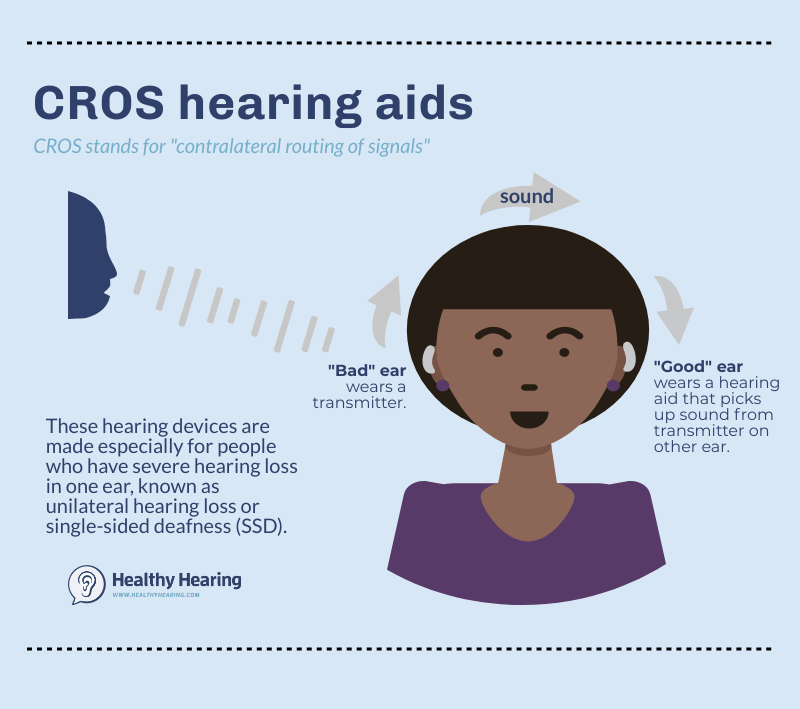|
www.HealthyHearing.com |
Hearing loss in one earAlso known as unilateral hearing loss, this condition creates unique hearing challenges
Contributed by Joy Victory, managing editor, Healthy Hearing Most people with hearing loss have what's known as "binaural" hearing loss, meaning both ears are affected. But some people may lose their hearing in just one ear. This can develop either at birth or later in life. This is known as unilateral hearing loss or single-sided deafness, depending on the severity of the hearing loss. It's generally referred to as "single-sided deafness" (SSD) when the degree of hearing loss is profound or near-profound. More on degrees of hearing loss. The hearing loss can occur gradually or suddenly. When it happens suddenly, it requires prompt treatment and should be considered a medical emergency. This is known as sudden sensorieneural hearing loss (see below).
How hearing loss in one ear affects hearingWe were designed to have two ears for a reason—the brain uses both ears to pinpoint the location of a sound, and to improve hearing quality and range. Losing hearing in one ear presents unique challenges. Depending on the severity of your hearing loss:
The 'head shadow' effect of single-sided deafnessIf you have single-sided deafness, you will likely experience something known as the "head shadow" effect. Due to the way sound waves travel, high-frequency sounds don't "bend" around to the side of the functional ear, meaning a person never hears them. "The head essentially acts as a shield, blocking sounds from the poorer hearing ear from reaching the better hearing ear," explained Cleveland Clinic audiologist Sarah Sydlowski. The end result is that speech can sound muffled, because a person can't hear high-frequency sounds like "s" or "f." Causes of hearing loss in one earThere are a number of potential causes of hearing loss in just one ear, including but not limited to:
Sometimes a cause can't be identified, or is due to a combination of factors. Sudden hearing loss in one earHearing loss in one ear can develop quickly—you should always act fast if you or a loved one experiences sudden hearing loss of any severity. As it develops, you may also notice you have "double hearing," known as diplacusis.
The quicker you seek treatment, the better your chances are for a full recovery. When hearing can't be fixed with medical treatment, single-sided deafness is often the result, which happens about 15% of the time. Treatment options for single-sided deafnessFor people with mild to moderate hearing loss, a hearing aid may be all that's needed to amplify the sounds you're not hearing. Severe to profound single-sided deafness is often permanent, but sometimes treatable with devices worn on your functioning ear. Your audiologist will perform a hearing test, and ask you questions to try and identify the cause of your hearing loss. From there, he or she might recommend a CROS, BiCROS, or bone-anchored hearing system: Contralateral routing of sound (CROS) system A CROS hearing aid system is designed for people with near-total hearing loss in one ear, but normal hearing in the other. A CROS detects the sounds occurring on the deaf ear, and routes them to the good ear. This requires wearing a device on each ear: On the non-functional ear, the person wears a transmitter device, and in the functional ear, the person wears a receiver that processes the sound and delivers it via a microphone. This sound is not amplified beyond normal because the person has relatively normal hearing. BiCROS hearing aids work the same way, except they're designed for people whose functional ear has moderate-to-severe hearing loss. This means the functional ear not only receives sound from the transmitter on the other ear, it is also receives amplified sound via a typical hearing aid. Several different manufacturers make CROS and BiCROS hearing aids. More: What are CROS and BiCROS hearing aids? It's important for patients to realize these devices re-route sound, but do not "restore" hearing to the deaf ear, according to Erika Woodson, MD, Medical Director of Cleveland Clinic’s Hearing Implant Program, in an online discussion with patients about the devices. "You will not hear in stereo. The benefits of these hearing strategies are to improve awareness of sound from 360 degrees, but you will not be able to localize sound." Bone-anchored hearing systems
bone-anchored hearing aid. Image courtesy Oticon Medical Some people do not find CROS hearing aids helpful. An alternative is a bone-anchored hearing system, which requires surgical implantation. These devices, also known as bone-anchored auditory implants, send sound vibration directly to the inner ear through the skull bone, a process known as bone conduction. This can be helpful because middle ear and ear canal problems might prevent sound waves and signals from reaching the inner ear. In those cases, standard hearing aids are ineffective. Here's how to know if a bone-anchored hearing system will help your single-sided deafness. Cochlear implants work by directly stimulating the auditory nerve. They are not normally used for single-sided deafness, though the FDA in July 2019 did approve a cochlear implant device from Med-El specifically for single-sided deafness. For more informationIf you are interested in hearing solutions for single-sided deafness, visit a local ear, nose and throat physician. Oticon Medical, which makes the Ponto 4 bone-anchored hearing system, also has a searchable directory of providers. Joy Victory, managing editor, Healthy Hearing
|
Featured clinics near me
Hearing Health Solutions from Ohio ENT - Columbus
974 Bethel Rd Ste B
Columbus, OH 43214
Earzlink Hearing Care - Reynoldsburg
7668 Slate Ridge Blvd
Reynoldsburg, OH 43068

Find a clinic
We have more hearing clinic reviews than any other site!



 Joy Victory has extensive experience editing consumer health information. Her training in particular has focused on how to best communicate evidence-based medical guidelines and clinical trial results to the public. She strives to make health content accurate, accessible and engaging to the public.
Joy Victory has extensive experience editing consumer health information. Her training in particular has focused on how to best communicate evidence-based medical guidelines and clinical trial results to the public. She strives to make health content accurate, accessible and engaging to the public.